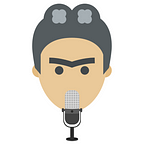Hannah HÖCH — one of the originators of photomontage
Disclaimer: The information provided in this episode comes from multiple sources and is not my scientific studies or discoveries. All authors and sources are credited at the end of this article. Thank you!
Welcome to HerArt podcast, a project for art lovers, especially art created by women. In our third episode, we will talk about Hannah HÖCH — one of the originators of photomontage. My name is Nata Andreev and I am going to tell you seven curious facts that you didn’t know about the artist was an early feminist and questioned conventional ideas about women’s role in society, gender relationships, beauty, and the making of art.
Curious Fact #1
Anna Therese Johanne Höch was born in 1889 in Gotha, Thuringia. Her father was in insurance and the family comfortably off. Though she showed an aptitude for art early on the family was not willing to support her ambitions and it was only in 1912, at the age of 23, she left home to study painting at the Charlottenburg School of Applied Arts in Berlin.
Curious Fact #2
The war temporarily interrupted her studies but three years later, when she was 26, Hannah met Raoul Hausmann, who was to become her lover and dada collaborator, either at the School of the Museum of Applied Arts, where, in deference to her father, she was studying handicrafts such as lace-making and embroidery or at the Sturm Gallery, the centre of Expressionist painting. It was at about this time she changed her name, simplifying it to Hannah.
Curious Fact #3
She had split from Hausmann in 1922, and at the end of the decade, having moved to the Netherlands, she began a lesbian relationship with the Dutch writer Til Brugman. Perhaps as a response to her relationship, Höch produced several curiously erotic photomontages in the early 30s. Androgyny also piqued Höch’s interest by providing her with an ideal resolution to polarising gender issues.
Curious Fact #4
Höch claimed she had hit on the technique of photomontage while on a Baltic holiday with the married Hausmann in 1918; having come across mocked-up photos sent home by German soldiers, in which the young men’s heads were superimposed on pictures of musketeers, they realized the power of cut-and-paste to “alienate” images. This origin tale is slightly misleading, however, because since 1916 Höch had been working for the Berlin publisher Ullstein, producing embroidery and lace designs for two periodicals. She was probably already familiar with the kinds of collage that an expanding print media practiced with photographs. Höch worked on these handicraft magazines for a decade, and even wrote a manifesto of sorts for modern embroidery, in which she enjoined Weimar-era women to “develop a feeling for abstract forms”.
Curious Fact #5
Her collages and montages often combined male and female into one being. Höch was commenting on the fact that during the Weimar Republic, “mannish women were both celebrated and castigated for breaking down traditional gender roles.” Her photomontages from the 1920s focused almost exclusively on issues relating to the construction of women’s identity and gender relationships. Her androgynous characters could also have been related to her bisexuality. Her work from 1926 to 1935 depicted same-sex couples.
Curious Fact #6
In 1932 the Nazi party canceled an important Höch exhibition before its scheduled opening. From then until the fall of the Nazi regime in 1945, Hannah was unable to show her work in Germany altogether. She had to assume a low profile to survive in Germany during the war and lived as an “inner emigrant,” a term applied to artists and intellectuals who continued their work privately, without bowing to Nazi ideology. She described those years as “twelve years of misery.” Her work survived Nazi Germany but remained unseen without critical review until the early 1960s for reasons that included sexism and the artist’s own resistance to showing it.
Curious Fact #7
Höch died in 1978, her place in 20th‑century art history almost, but not quite assured. Postwar histories of dadaism tended to patronise at best; she does not appear at all in Robert Motherwell’s 1951 Dada Painters and Poets, and Hans Richter, in 1965, called her “the girl who procured sandwiches, beer, and coffee, on a limited budget.” But gradually she snuck into the canon — she was part of the major Dada, Surrealism and their Heritage exhibition at the Museum of Modern Art in 1968 — and scholars and curators have since belatedly recognised that she was both a key dadaist and considerably more: a true pioneer of photomontage and a complex, funny critic of mainstream and art-world misogyny alike.
Thank you so much for listening to the eleventh episode of season three of HerArt podcast — a project for art lovers, especially art created by women. If you want to follow more of what I do, find me on Facebook and Instagram. And don’t forget to tune in next month, for our last episode in season three when I am going to tell you about Zinaida Serebriakova — one of the first Russian women who entered the history of painting. This is the ninth episode I am recording during COVID-19. I hope everyone is safe and takes care of themselves and their loved ones. And don’t forget END SARS because BLACK LIVES MATTER!
References
